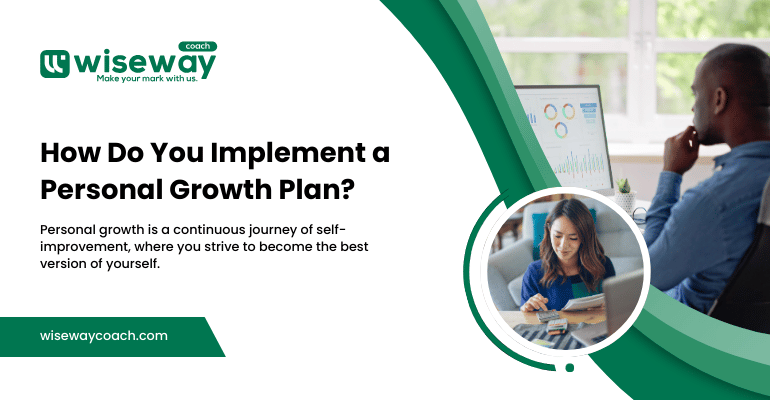How Do You Implement a Personal Growth Plan?
November 20, 2024 2024-11-19 16:05How Do You Implement a Personal Growth Plan?
Personal growth is a continuous journey of self-improvement, where you strive to become the best version of yourself. Implementing a personal growth plan involves setting goals, creating a strategy, and taking consistent actions to achieve those goals. Whether you aim to advance in your career, enhance your skills, improve your health, or enrich your relationships, a well-structured personal growth plan can guide you toward success. Here’s how you can implement a personal growth plan effectively.
1. Assess Your Current Situation
Self-Reflection
Start by evaluating where you are in various aspects of your life. Reflect on your career, personal relationships, health, finances, and overall well-being. Identify areas where you feel satisfied and those where you see room for improvement. Self-reflection helps you understand your strengths, weaknesses, and areas that need attention.
Gather Feedback
Seek feedback from trusted friends, family members, colleagues, or mentors. Their perspectives can provide valuable insights into your behavior, skills, and areas for growth. Constructive feedback can highlight blind spots and help you gain a more comprehensive understanding of yourself.
2. Define Your Goals
Set SMART Goals
SMART goals are Specific, Measurable, Achievable, Relevant, and Time-bound. Clearly define what you want to achieve, ensuring your goals are realistic and aligned with your values and long-term vision. For example, instead of setting a vague goal like “improve my health,” specify it as “lose 10 pounds in three months by exercising three times a week and following a healthy diet.”
Prioritize Your Goals
Determine which goals are most important to you and focus on those first. Prioritizing helps you allocate your time and resources effectively, ensuring you make steady progress without feeling overwhelmed.
3. Create an Action Plan
Break Down Goals into Actionable Steps
Divide your larger goals into smaller, manageable steps. This makes the process less daunting and allows you to track your progress more easily. For example, if your goal is to learn a new language, your action steps might include enrolling in a course, practicing daily, and conversing with native speakers.
Set Milestones and Deadlines
Establish milestones and deadlines for each step to keep yourself accountable. Milestones are smaller achievements that mark your progress toward the larger goal. Deadlines create a sense of urgency and help you stay on track.
4. Develop Positive Habits
Identify Key Habits
Identify habits that will support your personal growth and incorporate them into your daily routine. These might include reading, exercising, meditating, or networking. Positive habits reinforce your commitment to your goals and contribute to long-term success.
Use Habit-Tracking Tools
Use habit-tracking tools or apps to monitor your progress. These tools provide visual reminders and track your consistency, helping you stay motivated and accountable.
5. Seek Learning and Development Opportunities
Continuous Learning
Commit to lifelong learning by seeking opportunities for personal and professional development. Attend workshops, take online courses, read books, and listen to podcasts. Staying curious and open to new knowledge broadens your perspective and enhances your skills.
Find a Mentor or Coach
A mentor or coach can provide guidance, support, and accountability. They can share their experiences, offer advice, and help you navigate challenges. Building a relationship with a mentor or coach can accelerate your personal growth and help you achieve your goals more efficiently.
6. Monitor and Adjust Your Plan
Regularly Review Your Progress
Set aside time to regularly review your progress. Assess what’s working and what isn’t, and make necessary adjustments to your plan. This helps you stay flexible and adapt to changing circumstances.
Celebrate Your Achievements
Acknowledge and celebrate your achievements, no matter how small. Celebrating milestones boosts your motivation and reinforces the positive behaviors that led to success.
7. Overcome Challenges
Stay Resilient
Personal growth often involves overcoming obstacles and setbacks. Develop resilience by maintaining a positive mindset, staying focused on your goals, and learning from failures. Resilience helps you bounce back from challenges and keeps you moving forward.
Seek Support
Don’t be afraid to seek support when needed. Reach out to friends, family, mentors, or support groups. Surrounding yourself with a supportive network can provide encouragement, advice, and a sense of community.
8. Maintain Balance
Prioritize Self-Care
Personal growth should not come at the expense of your well-being. Prioritize self-care by ensuring you get enough rest, eat healthily, exercise regularly, and take time for relaxation and hobbies. A balanced approach helps you stay energized and focused.
Set Boundaries
Set boundaries to protect your time and energy. Learn to say no to commitments that don’t align with your goals or values. Setting boundaries helps you maintain focus and prevents burnout.
Conclusion
Implementing a personal growth plan involves a thoughtful and structured approach to self-improvement. By assessing your current situation, defining clear goals, creating an action plan, developing positive habits, seeking learning opportunities, monitoring your progress, overcoming challenges, and maintaining balance, you can achieve your personal and professional aspirations. Remember that personal growth is a continuous journey, and staying committed to your plan will lead to meaningful and lasting change.


